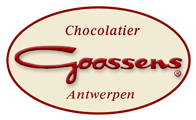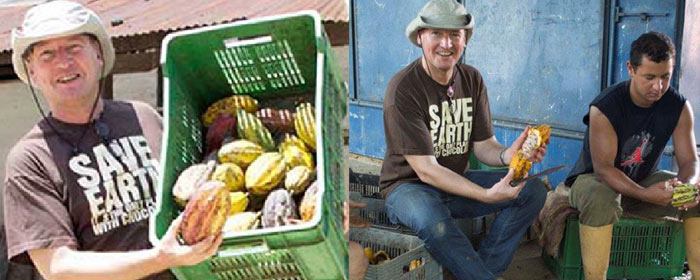To make some of the most awarded Belgian chocolates, Erik Goossens begins by looking for the finest and natural ingredients. He personally selects exceptional cacao growers who will meticulously harvest, ferment and dry the beans. They simply must share the same passion for quality as Erik does. This is essential in the process of creating the finest chocolate possible.
Cacao beans

Cacao beans are the seeds of the fruit of the Theobroma Cacao, a medium-sized evergreen tree growing in the wet lowland tropics of Central and South America, West Africa and Southeast Asia. Its name is derived from the Greek words “theo” (God) and “broma” (food), meaning “food of the Gods”. There are four sub-species of the Theobroma Cacao: Criollo, Forastero, Nacional and Trinitario, and just as with grapes or coffee, take the same cacao bean, plant it in a different micro-climate and soil, and the result will taste different. The above photo of cacao beans shows some of the single origin or hybrid beans. Erik Goossens selects mostly cacao beans from single estates in Peru (rare Amazon Criollo), Venezuela (Chuao and Ocumare), Madagascar (Criollo with a unique acidic touch) and the famous pale Porcelana beans from Java (Indonesia), mostly used for his milk chocolate.
The processing of cacao beans
When the cacao fruit is ripe, it is harvested and split open. The beans and pulp are removed (40 to 50 beans per pod), and then covered with banana leaves and fermented for 5 to 7 days. The fermentation changes the color of the beans from reddish brown to dark brown, takes away the astringency, and adds flavor and complexity. To stop the fermentation process, the beans are uncovered and separated from the pulp, and spread out to dry in the sun. Many growers speed up this process, as they are providing their beans to cooperatives or huge conglomerates which represent 90% of the world harvest. They will often shorten the fermentation process which results in a lack of color and complex taste. Also, beans will be often dried over fires instead of being dried in the sun, which creates undesirable smoky flavors. Erik Goossens excludes cacao beans from producers who use these practices.
Finally, the dried beans are shipped to the manufacturer where they are roasted and crushed into pieces (nibs). This develops the color and flavor of the beans into what our palates expect from fine chocolate. These nibs eventually will be crushed again (conching) forming a smooth paste called “cocoa liquor”, “cocoa mass” or “unsweetened chocolate”. This mass can be pressed and separated into cocoa powder and cocoa butter which can be added to another batch of cocoa mass in order to enrich and smoothen it or to make white chocolate. If the cocoa mass is not separated, sugar, vanilla and lecithin (an emulsifier produced from soya) can be added in order to make the final product – dark chocolate. Milk can be added to make milk chocolate. White chocolate is made by mixing cocoa butter, sugar, lecithin and milk powder.
Cocoa butter imparts no flavor or aroma at all to the finished chocolate. It is a fat with a very low melting point (it melts at body temperature) and brings the wonderful smoothness to chocolate. As mentioned above, sometimes cocoa butter is removed from the cocoa mass and replaced by vegetable oils with a higher melting point. This not only changes the texture of the chocolate to its detriment, but makes it less prone to melting during transport since it has a higher melting point. In some cases, the vegetable oils used are unhealthy. Needless to say, Maître Chocolatier Erik Goossens only uses chocolate made with 100% cocoa butter!


You must be logged in to post a comment.